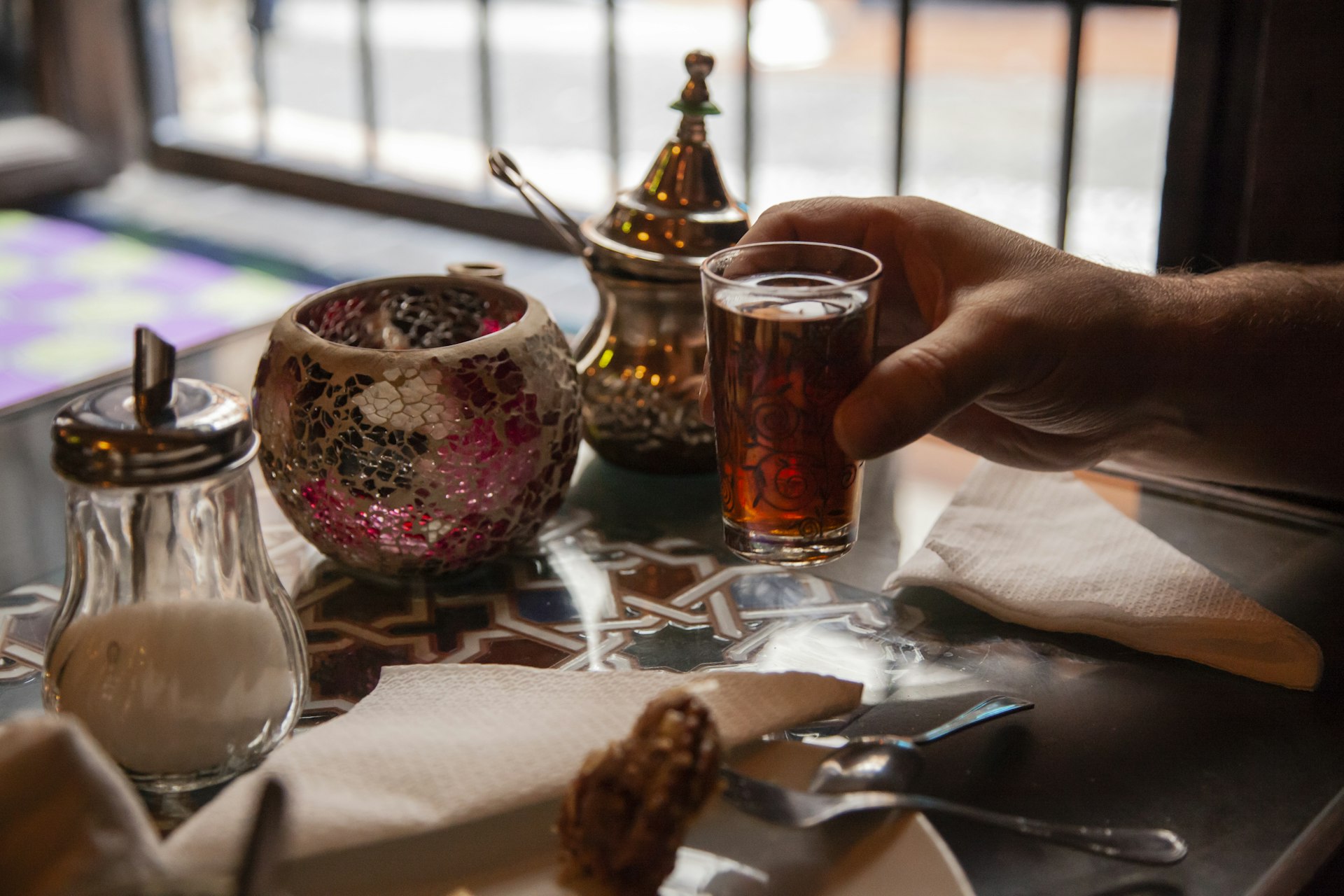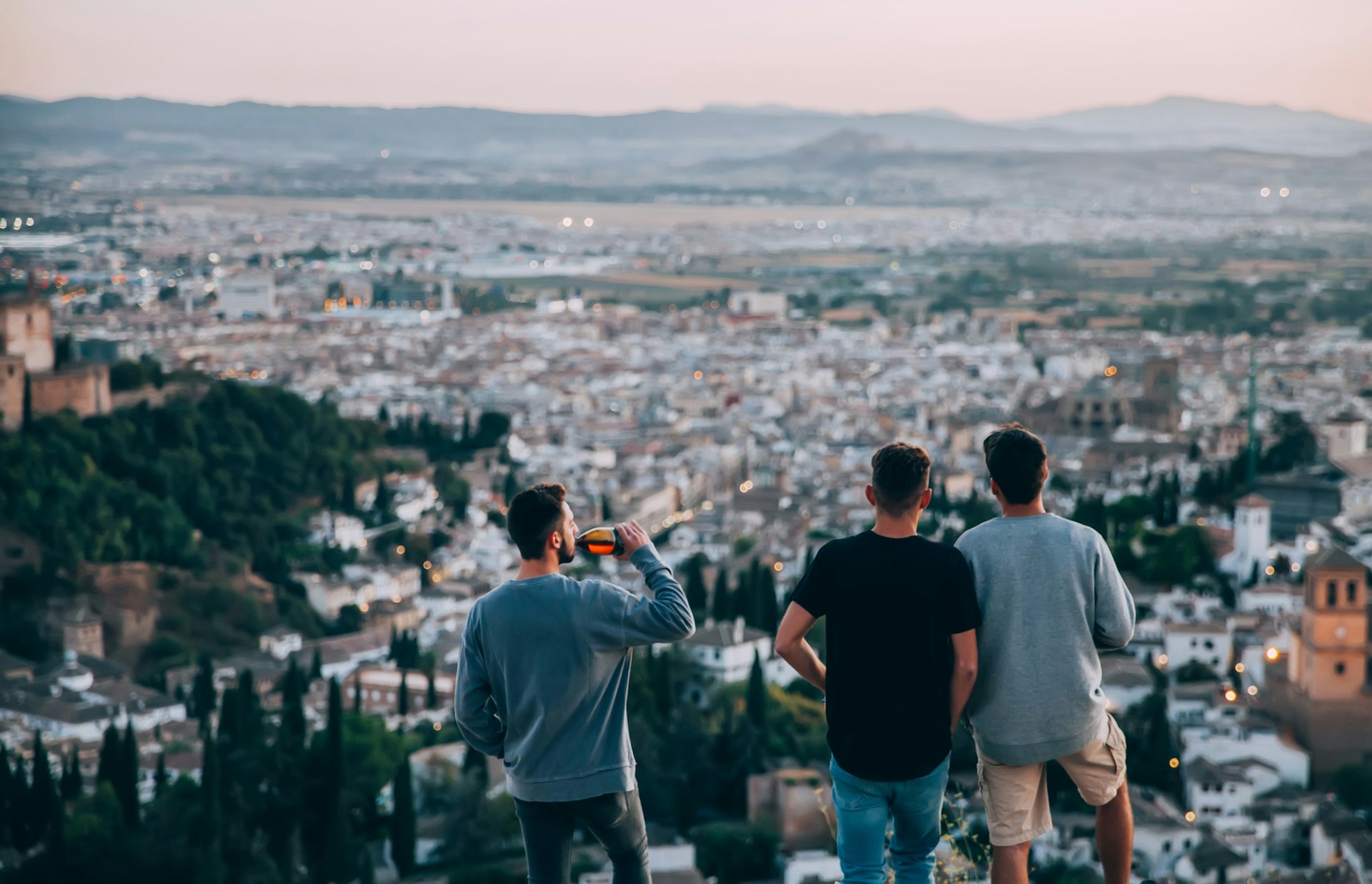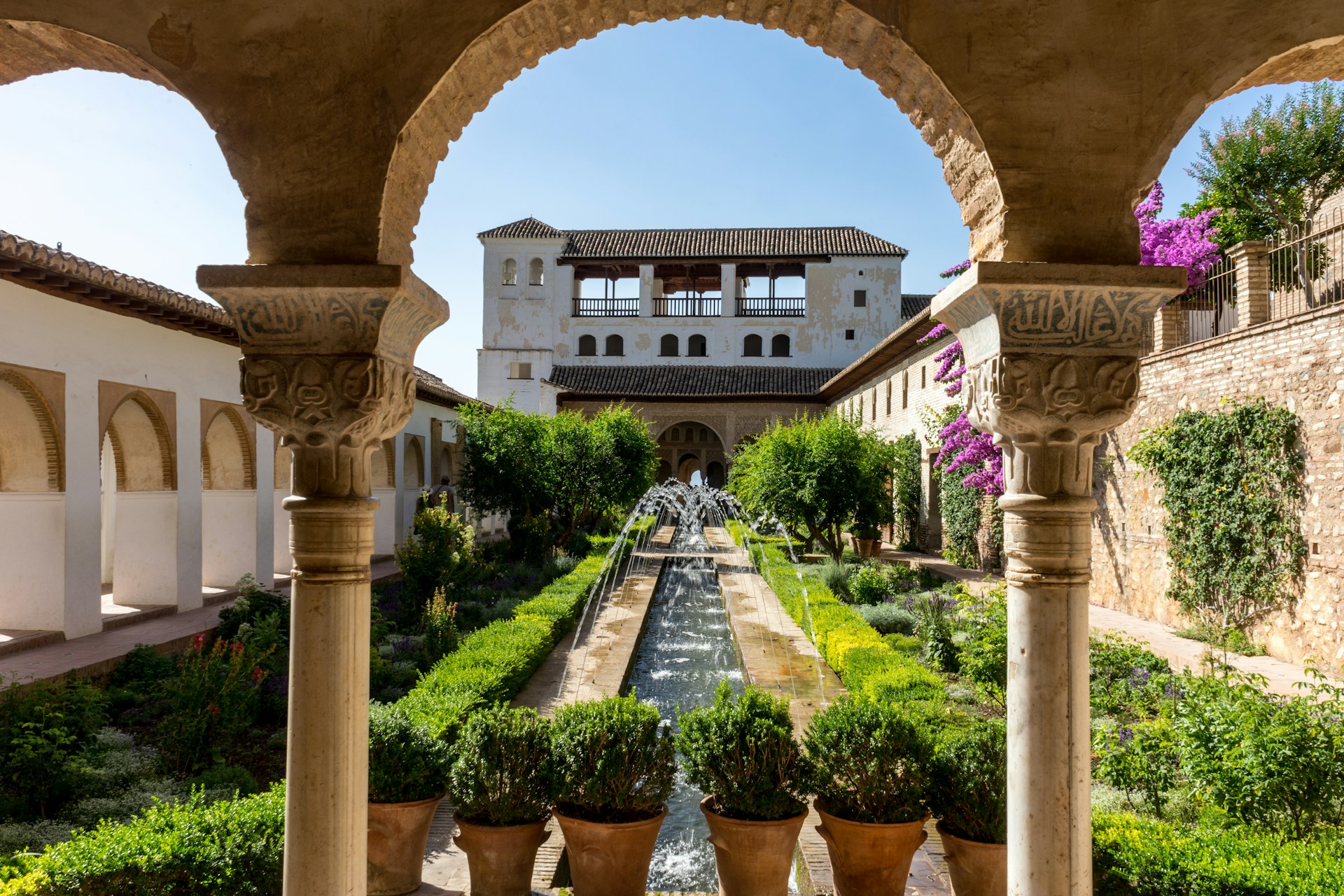Granada is Spain’s cultured, creative southern city; a place with a storied past centering on the Alhambra, one of the world’s great human-made wonders.
To the Moors it was a paradise on Earth, to the Reyes Católicos (Catholic Monarchs), who succeeded them, Granada became the seed from which a global empire grew.
Today, the legacy of Granada’s historic diversity remains the key reason to visit. There are former Jewish (El Realejo), Roma (Sacromonte) and Muslim (Albaicín) neighborhoods of winding cobbled streets waiting to be explored, where you might hear the plaintive arpeggios of a flamenco guitar fluttering through the warm air. There are also attractions for gourmands, history buffs and appreciators of all things musical and literary. Make the most of your trip with these top things to do in Granada.
1. Witness Moorish perfectionism at the Alhambra
Granada is best known for its world-class Alhambra, a majestic hilltop stronghold, consisting of ornately decorated palaces (Palacios Nazaríes), robust fortifications (the Alcazaba) and graceful gardens (the Generalife). As you wander through its lavishly stuccoed palace rooms, and courtyards anchored by burbling marble fountains, it’s easy to imagine the emirs reclining in the shade, savoring life’s finer things. That was the underlying philosophy behind such exquisite buildings: that life is transitory and best appreciated in the present.
Planning tip: Entry to the Nasrid Palaces is by timed ticket (usually an hour after your purchase) so start your visit at the Alcazaba, then proceed on time to the Nasrid Palaces and end your visit in the Generalife gardens. Book online in advance to grab an earlier time slot, before the masses descend.
2. Visit interred royals at the Capilla Real
Although nothing that the conquering Reyes Católicos built, after recapturing Granada from the Moors in 1492, rivals the Alhambra, the Capilla Real (Royal Chapel) comes closest. While the Moorish palace was built to celebrate life, the finest post-Reconquista building is dedicated to death. Within the Gothic chapel, which adjoins Granada Cathedral, the ornate marble tombs of the revered monarchs Ferdinand and Isabella lie behind a protective wrought iron barrier. Most of the royal remains are boxed up in lead coffins in the crypt below.
3. Wax lyrical about Lorca’s Granada
Nobody has encapsulated the alluring landscapes and haunting culture of Andalucía quite like Federico García Lorca (1898–1936). A little sliver of his “Parched land, quiet land, of immense nights” can be explored at Huerta de San Vicente. It was here in his summer house on the western edge of the city, surrounded by the bucolic poplars, palms and ponds of Parque Federico García Lorca, that he wrote many of his finest poems and plays. Visits are by guided tour only from Wednesday to Friday, apart from in August, when the house is closed.
Detour: For a deeper dive into Lorca lore, head out to Museo Casa Natal in the village of Fuente Vaqueros, 17km (13 miles) from Granada. This was the indomitable poet’s birthplace, where he spent his early childhood years.

4. Add too much sugar to your mint tea at a tetería
You won’t find clusters of teterías in most other Spanish cities because they’re a remnant of the Moorish culture that the emirs left behind when Boabdil was sent packing into the Sierra Nevada mountains. Arabesque flourishes at Tetería Dar Ziryab or the excellent Middle Eastern cuisine, such as mutabal and baba ganoush, of Tetería Palmira uphold the theme. Locals load up on mint tea (spare the milk but be liberal with the sugar), poured into glasses from stainless steel pots.
Planning tip: The densest concentration of teterías is around the intersection of calles Elvira and Calderería Nueva, two blocks east of the cathedral.
5. Crawl the tapas bars for free food
Perhaps even more astounding than the timeless beauty of the Alhambra is the fact that it’s still possible, in this day and age, to chow down on free tapas in Granada. The practice of providing a small plate of food with every drink purchase was once widespread in Spain. Now it’s almost exclusively limited to Granada and its environs. Stalwarts like Bar Poë even have a menu offering a choice of over 10 dishes, including estofado de carne (piri-piri pork stew) or ensalada de garbanzos (chickpea salad).
Planning tip: There are bars offering free tapas throughout the city, although if you head to the Realejo neighbourhood, southwest of the Alhambra, you’ll find plenty of traditional-style bars, such as Bar Los Diamantes on Calle Navas. A useful phrase to remember is vamos a tapear, or loosely: let’s go tapas bar hopping.
6. Notice the blend of architectural styles in Mudéjar buildings
Formerly a mosque, the Church of San Gil y Santa Ana is a fine example of the religious one-upmanship typical of Andalucía’s historic buildings. While the Catholic Baroque style is mostly in evidence, look up to see the exquisitely carved wooden artesonado ceilings. Other fascinating remnants of heritage from this era include the Corral del Carbón, so named for its former use as a coal warehouse, but which began life as a 13th-century caravanserai. Nearby, the Palacio de la Madraza, sited beside the cathedral, may have a Spanish Baroque exterior, but the arabesque stucco within is undoubtedly Mudéjar.

7. Experience one of Spain’s finest views
Practically every vista towards the snowcapped Sierra Madre peaks from Granada’s Albaicín neighborhood is dominated by the imperious Alhambra. Complete a late-afternoon stroll of the Albaicín’s narrow, cobbled streets at a mirador (lookout point) in time for the sunset. The most impressive view is from Mirador de San Nicolás, although many visitors to Granada book their accommodation in the Albaicín, too, so that they can start and end their day with this vista.
Planning tip: The streets in this area include steep sections and lots of steps so bring appropriate footwear. Hotels higher up the hill, north of the Darro River, offer the best views. Good options include Casa Bombo and Hotel Santa Isabel la Real.
8. Attend a flamenco performance in a Sacromonte cave
Romani heritage is in fine evidence throughout the Sacromonte neighborhood in Granada’s northeast. Many of the oldest homes were built in the naturally abundant caves of these Sierra Nevada foothills. The caves nurtured an arrestingly emotive version of the flamenco artform, where every guitar-backed grito is suffused with the pain of an oppressed existence. Today there are dozens of nightly shows in the Sacromonte playing this form of flamenco called Granaína, many of which benefit from the unique acoustics of their cavern settings. Among them are Zambra María la Canastera, and Cueva de la Rocio.
Planning tip: There are plenty of other great places to catch a flamenco performance elsewhere in Granada. These traditional, non-cave flamenco theaters are known as tablao. Some offer dinner and a show, such as Tablao Flamenco La Alborea, while others focus purely on the art.
9. Brush up on Inquisition history at Palacio de los Olvidados
For a long time, the Inquisition remained a shameful and unacknowledged passage of Spain’s past. These days, it can still feel like an unresolved issue, but museums such as the Palacio de los Olvidados go some way towards examining the period of deadly extremism that followed the overthrow of the Moors in Granada, as a way of quelling anti-Catholic sentiment. The museum’s main exhibit is of torture devices used during this time, coming close to, but not fully achieving an honest appraisal of this shameful era, but without trivializing it either.
10. Shop for rare ceramics at Fajalauza
If you’re planning to explore the upper reaches of the Albaicín and are looking for other fun things to do, be sure to stop by Fajalauza. Rumors have persisted for years that this final bastion of Granaína ceramics is due to close its doors. In operation since 1517, the family-run factory has passed through dozens of generations. The exhibition and sales room is an ideal place to find a unique, hand-painted souvenir.
